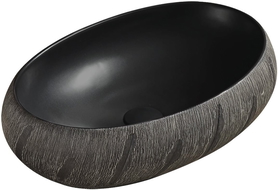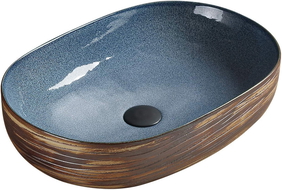
The question of how to choose a basin tap is more important than it might seem at first glance. It's worth dedicating some time when setting up a bathroom. You will find various types of basin taps on the market, making it easy to match the fittings to the space you're arranging. Remember that the correct choice of basin tap is crucial for the functionality, aesthetics, and comfort of use in the bathroom. Learn why installation method, spout length, type of basin, and other issues should be considered when purchasing such fittings.
What will you learn from this article?
When choosing a basin tap, various aspects need attention. From our article, you will learn:
-
How to choose a basin tap that is functional and suits the style of the bathroom.
-
What types of basin taps are there and how their installation methods differ.
-
The advantages and disadvantages of pillar taps and wall taps.
-
How to match the spout length and installation height of the tap to the type of basin.
How do we classify basin taps?
An important criterion for division is the size and installation method of the bathroom tap. You have two options to choose from:
-
wall-mounted basin taps,
-
pillar basin taps.
Among the latter, we distinguish:
-
basin taps mounted on a countertop,
-
basin taps installed on the edge of the basin,
-
floor-mounted basin taps.
Models mounted directly on basins are popular. An interesting but costly type is the floor-mounted or freestanding basin tap (e.g., Mexen Alma), used with freestanding basins. This type of fixture is mainly intended for large bathrooms or bathing rooms.
An important selection criterion is also the number of handles. Here, consider whether you will go for a traditional tap with two knobs or choose a single-lever one with a water mixer. In guest bathrooms or toilets, a touchless basin tap will be the ideal solution.
Pillar or wall – how to choose a basin tap?
The choice of a suitable bathroom tap affects the comfort of daily use and the appearance of the entire interior. When deciding to purchase, you should pay attention to several important issues such as types of taps, installation methods, and dimensions, including spout length. Matching the size of the basin tap is especially important to avoid water splashing. I'll now explain the advantages and disadvantages of a pillar tap and the characteristics of wall-mounted taps.
Pillar basin tap – advantages and disadvantages
A pillar basin tap is very popular due to its practicality and a wide range of design options. It suits countertop, undercounter, or bowl basins. Before deciding to buy, it's worth considering a few issues to ensure the selected basin tap meets all expectations and matches other fittings.
An essential aspect is the material that affects its durability and scratch resistance. Also, ensure the tap has an appropriate aerator, which provides significant water savings while maintaining a comfortable stream. The valve of the tap should be sturdy to avoid wear problems.
Pay attention to the ease of seal replacement and availability of spare parts, ensuring hassle-free use for a long time. The shape of the spout is also an important aspect, which should be practical and matched to the size and type of basin.
Advantages of a pillar basin tap:
-
easy tap installation,
-
wide range of models (e.g., black, chrome, brass),
-
easy adjustment of water flow,
-
comfortable height for hand washing,
-
the possibility to easily adapt to various bathroom styles,
-
many spout length variants allow matching the tap to different basin sizes.
Disadvantages of a pillar tap:
-
need to make an appropriate hole for the tap,
-
requires careful size selection to avoid water splashing issues,
-
sometimes its height may be inconvenient for children or the elderly.

Wall tap – pros and cons
Wall taps are a popular solution. Pay attention to the spout reach and distance from the basin when installing such fittings. Before installation, it's a good idea to check what height of the tap will ensure easy use and hassle-free hand washing. Select the size of the tap so its length doesn't cause splashing beyond the edge of the basin.
Wall mounting can be more aesthetic if you want a minimalist finish to the interior. The tap doesn't have to be fully visible – in the case of concealed taps, only the spout and handles remain visible, enhancing aesthetics.
Wall solutions work well with countertop basins where there is no hole for a tap. Many people choose a wall version basin tap for space-saving on the countertop. This solution is practical and convenient, especially in small spaces.
Another advantage is the ability to independently determine the height at which the tap is mounted. This freedom is important if you want to adjust its position to users' height, unusual ceramic forms, or other bathroom elements.
Pros of a wall tap:
-
space-saving on the basin,
-
elegant appearance (especially built-in models),
-
possibility of mounting at any height,
-
greater flexibility in bathroom design,
-
no restrictions due to the presence of a hole in the ceramic.
Cons of wall-mounted taps:
-
requires precise installation planning,
-
harder access to hidden components in case of failure,
-
not every wall suits installation,
-
harder to correct positioning if installed wrongly,
-
can be challenging to match a tap fitting previously installed ceramics.
Which basin tap is the most convenient to use?
When purchasing a bathroom tap, pay attention to the height of the tap and spout length. It should reach the basin chamber without risking water spills on the ceramic edge. If you opt for a pillar tap intended to be installed in a small surface-mounted basin, choose a suitable size with a shorter spout to avoid water splashing. Your chosen basin must have tap holes.
For a wide basin, do not mount a tap with a short spout, barely reaching beyond the bowl's edge, as it will be uncomfortable to use. Choose a model with a extended body and contoured spout. Here, a cascading model will also work perfectly. It will not only pass the functional test but also provide users with unique experiences during use and significantly enhance the bathroom's aesthetics.
When opting for a wall-mounted basin tap, ensure its proper size and location. It should be located at a height of 25-35 cm above the upper edge of the basin to ensure easy access to the water stream. For a retro-style bathroom, you can choose a tap in antique gold, white, or black with styled handles, matching all fitting elements to the bathroom style.
The best bathroom taps for countertop basins
In the case of countertop basins, pillar taps standing next to the bowl look very attractive. However, remember to add approximately 15 cm to the height of the tap for the bowl depth. The spout length should correspond to 1/2 of the basin width. This ensures that the water stream will be directed at the central point of the basin bowl. You can only choose a basin tap installed on the countertop if access to the tap is unrestricted, and there is room on the countertop for toiletries and toothbrush accessories. Only then will the bathroom space be optimal and comfortable for each user.
When selecting taps and other bathroom equipment, consider the size of the room. A countertop basin looks best in larger interiors. In smaller bathrooms lacking space for a large countertop with a basin, cabinets work well. Just match the furniture, ceramics, and all other elements appropriately, and the bathroom will gain a unique style. Now that you know how to choose a basin tap, check out the amazing models of such fittings from Mexen.
Summary
If you're wondering how to choose a basin tap, this article has provided tips to facilitate decision-making. We discussed various types of taps, including concealed and pillar taps. The right choice depends on style, available space, and the solution's functionality. If you want to avoid splashing, increase comfort, and improve the interior's aesthetics, consider the shape, height, and spout length of the basin tap. The final choice also depends on the basin size, installation type, and whether the tap should be mounted on the countertop, wall, or next to the bowl.
Choosing fittings for our bathroom requires consideration of material, color, the presence of elements like a plug in the set, and whether the handles allow convenient water temperature setting. The right basin tap influences not only cleanliness but also everyday comfort and the final visual effect of the whole arrangement. If you've read this guide, you already know how to choose a basin tap to suit your needs, space, and bathroom style.






















